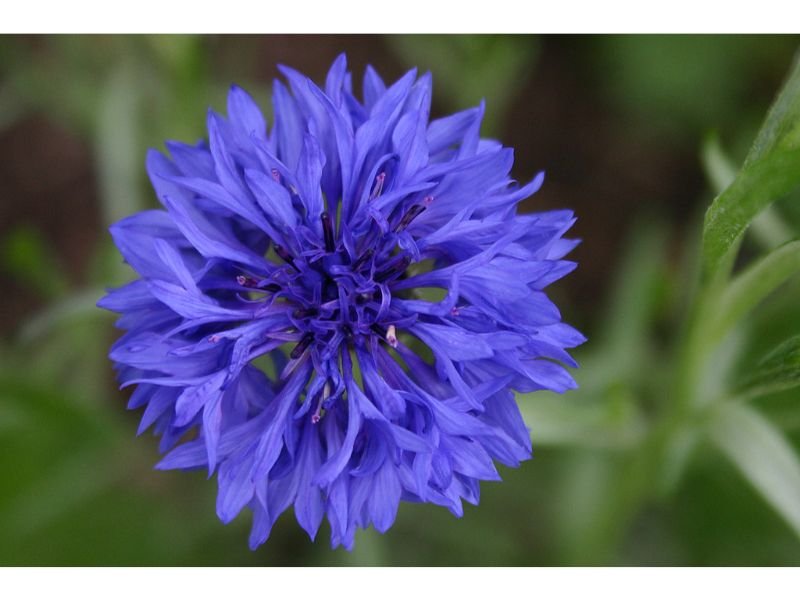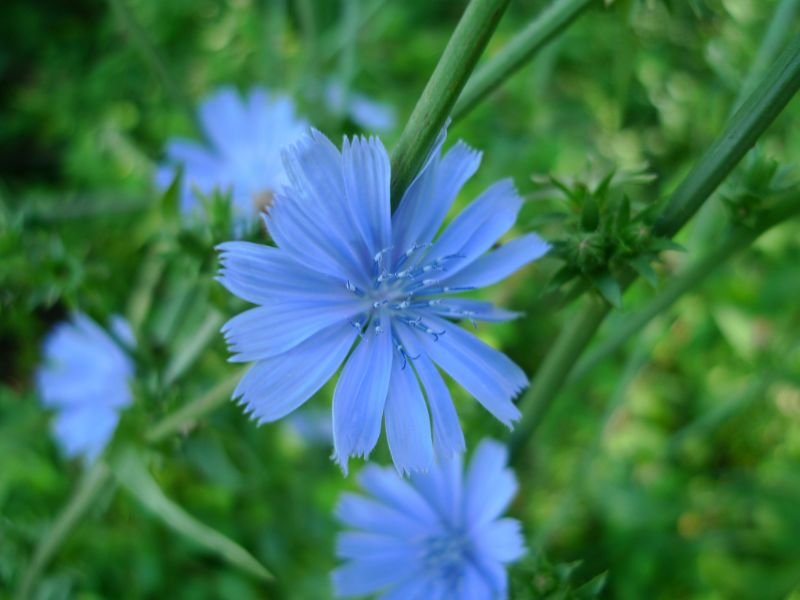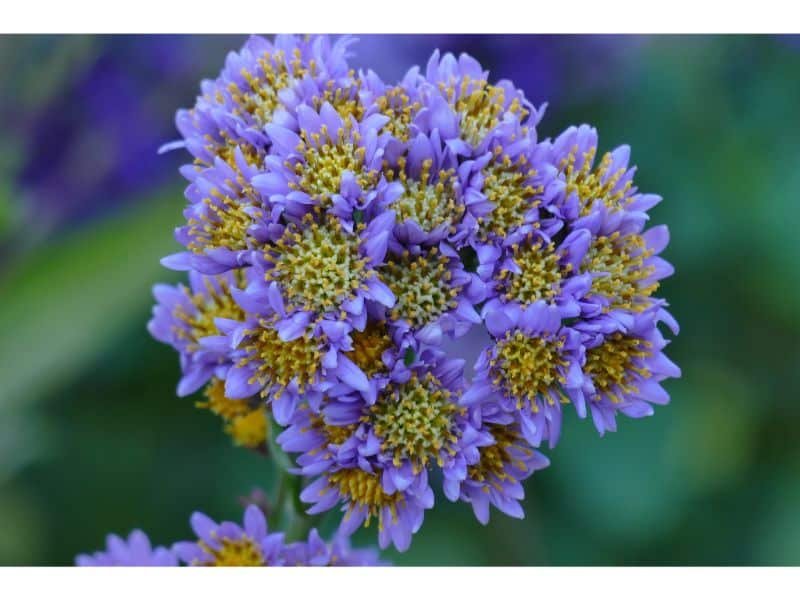Coneflower thrives in a wide array of colors and shades, from vivid crimson red to pale pink and even lime green. But have you ever wondered, is there any blue coneflower variety? If so, why is it not as notable as its yellow, pink, and purple cousins? And if blue coneflower is just a product of an imaginary tapestry, are there flowering plants that fit a similar niche? In this special section, we’re going to debunk the mystery surrounding the existence of this elusive flowering plant. So without further ado, let’s dig in!

Table of Contents
The Existence of Blue Coneflower: A Botanical Reality or a Horticultural Myth?
In general, yes, blue coneflowers are real. However, the term real ‘blue cornflower’ here refers to a group of flowering plants, mainly from the Asteraceae or aster family, that have cone-shaped flowers, with or without daisy or aster-like petals, and blooms in shades of blue. Echinacea purpurea or simply echinacea, which is best known as coneflowers, unfortunately, does not produce blooms in this rare hue.
Out of the eight to nine species, including many types of its cultivars, this native to Central and Eastern regions of the United States blooms in shades of pink including rose pink and magenta, white including broken white, shades of red including crimson red and burgundy, shades of yellow and orange including salmon-colored, shades of purple, and with an additional unique and rare green hue in various cultivars like Coconut Lime (Echinacea ‘Coconut Lime’). As you can see, echinacea comes in numerous gorgeous colorations–but not in blue. So to ring down the curtain, there’s no blue coneflower echinacea yet.
Will There Be a Blue Echinacea in the Future?
Yes, there is currently no known record of blue coneflower or a blue version of Echinacea purpurea that you can grow in your garden. However, due to the advancements in genetic engineering techniques, plant lovers can find a true blue coneflower echinacea in the future. Nonetheless, the creation, starting from genetic research to plant breeding, would take some more time and energy as well as huge expenses, so the time is likely uncertain.
8 Flowers to Check Out If You Crave for a Blue Coneflower Plant
Not getting the blue coneflower you’re looking for? There’s no need to feel blue! In this section, we provide all the blue echinacea alternatives that offer the same aesthetically-pleasing look and similar cultivation needs as Echinacea purpurea–but in shades of blue and coneflower-like blooms.
Bachelor’s Button (Centaurea cyanus)

Growing Zones: 3 to 10
Plant Type: Annual
Sun Preferences: Filtered to bright and direct
Bloom Season: Late summer
Not only this native to Europe and Eastern Asia and is often mistaken as the cultivar of Echinacea purpurea, but the flower itself is also nicknamed the blue coneflower! Bachelor’s button is characterized by its delicately layered petals that come not only in true blue color but also in white and pink, with a dark lavender-blue central disk. Bachelor’s button’s blooms are smaller than echinacea.
Chicory (Cichorium intybus)

Growing Zones: 4 to 8
Plant Type: Perennial
Sun Preferences: Bright, direct
Bloom Season: Late fall
Next, we got chicory which is also known as the echinacea’s doppelganger. Originating from the same plant family, this edible blue coneflower plant look-alike is composed of numerous small daisy-like blooms with towering green stems. Chicory has slender stems and elongated foliage, while echinacea purpurea has studier stems with lance-shaped leaves. Both are relatively low-maintenance plants.
Blue Stokesia (Stokesia laevis)

Growing Zones: 4 to 9
Plant Type: Perennial
Sun Preferences: Bright, direct-to-dappled light
Bloom Season: Early summer
Similar to the bachelor’s button, blue stokesia is also nicknamed the coneflower aster, thanks to its floral arrangement and growing needs. Blue stokesia has numerous, double-layered pointed petals with a lighter color, almost white, central disk. This plant mostly stays compact with a mounding growth habit.
Tatarian Aster (Aster tataricus)

Growing Zones: 3 to 9
Plant Type: Herbaceous perennial
Sun Preferences: Full, direct
Bloom Season: Early fall
Tatarian aster possesses the same ability as echinacea in terms of attracting pollinators, making this blue coneflower alternative a must-have for pollinator-themed gardens. It features daisy-like petals that grow in a lavender-blue hue, with a contrasting bright yellow center disk. Tatarian aster, however, is much taller than echinacea as it can grow up to 6 feet under the best circumstances.
Blue Daisy (Felicia amelloides)

Growing Zones: 8 to 10
Plant Type: Perennial, annual
Sun Preferences: Bright, direct
Bloom Season: Early summer
Also known as Blue Felicia, this blue coneflower alternative would easily capture anyone’s heart through its captivating appearance. Blue daisy is a native to South Africa that generally grows to only about 18 inches. It produces vibrant bright blue, single-layered, sparse aster-like petals with a dazzling yellow center–giving the impression of a classic daisy flower. In contrast with Echinacea purpurea, blue daisy is a smaller flowering plant with more bushy foliage.
Blue Erigeron (Erigeron speciosus)

Growing Zones: 5 to 7
Plant Type: Woody perennial
Sun Preferences: Full, bright
Bloom Season: Midsummer
It’s easy to confuse blue erigeron with tatarian aster due to their eerily almost-identical look. Both feature daisy-like blue-lavender petals with bright yellow disk centers, but blue erigeron produces pointy petals while tatarian aster got that more round look. Blue erigeron grows to a similar size to the regular echinacea with a bushy growth habit. Once established, equivalent to echinacea, blue erigeron manifests the talent of being a fairly drought-tolerant plant.
Chinese Aster (Callistephus chinensis)

Growing Zones: 3 to 11
Plant Type: Annual
Sun Preferences: Filtered shade to full, direct
Bloom Season: Early summer
Well, speaking about the appearance, Chinese aster might be slightly different from Echinacea purpurea, but this blue coneflower alternative is still worth looking at. Featuring not only blue, but also white, yellow, red, and purple layers of petals with bright yellow or white center–this plant surely would turn your living room into a merry festival with its showy cut flowers! As an annual plant, Chinese aster has a shorter lifespan than echinacea coneflower.
Blue Japanese Aster (Kalimeris incisa)

Growing Zones: 5 to 9
Plant Type: Perennial
Sun Preferences: Dappled shade to bright light
Bloom Season: Early fall
Out of the previous breathtaking blooms that we’ve introduced here, blue Japanese aster has the palest shade of blue-lavender hue, but it’s just as beautiful as the others. It has a daisy-like inflorescence with numerous petals radiating from a central pale golden disk. Although somewhat resistant to heat and drought, blue Japanese aster is more suited for temperate and cooler climates.
Why There Is No Known Blue Coneflower Cultivar?
There are coneflower varieties with unusual hues and bloom shapes, but why can’t we get a true blue coneflower? The absence of blue coneflower can be attributed to the lack of naturally occurring blue pigmentations in the genus Echinacea purpurea. This means that the genetic makeup of echinacea does not contain the genes to produce this scarce color in the world of botany. As a result, many breeders and horticulturists have not been able to develop a true blue variety of Echinacea purpurea.
Wrapping Up: The Truth About Blue Coneflower Plant
To answer your curiosity, as for now, there’s no known blue coneflower plant within the Echinacea genus, as this color is not naturally within the plant’s genetic code. While this may disappoint those who longing for a blue echinacea, you can always opt for its alternatives including bachelor’s button and chicory–as these plants also carry the same easy-to-maintenance trait and exquisite look!

New author in the hood. Loves gardening and flowers are my spirit animals (yes I know they are not animals but I insist). I will be covering most of the flowers’ topics here and occasionally random though as well.






